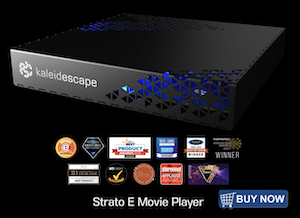Eric SVL
Member
Thread Starter
- Joined
- May 1, 2017
- Posts
- 173
More
- Preamp, Processor or Receiver
- Denon AVR-X4500H
- Main Amp
- Hypex NCore NC252MP
- DAC
- Micca OriGen G2
- Computer Audio
- iLoud MTM
- Universal / Blu-ray / CD Player
- Sony PS3, PS4
- Streaming Equipment
- Google Chromecast
- Streaming Subscriptions
- GIK Tri-Traps
- Front Speakers
- Buchardt S400
- Surround Speakers
- Polk LSiM 702
- Front Height Speakers
- Focal Chorus OD 706 V
- Rear Height Speakers
- Focal Chorus OD 706 V
- Subwoofers
- Rythmik
- Other Speakers
- ELAC Debut Reference DFR52
- Screen
- Samsung PN64H5000
Hey all,
I've been struggling with my response in the above-subwoofer-but-still-modal 100-300 Hz range, so I decided to try loading my front corners with bass traps. It wasn't the drop-in affair I expected. What follows are some pictures and measurements to document the experience.
Here is the system before the changes. Room is 16.9 L * 10.6 W * 8.0 H in feet.

Now, we start measuring and adding the GIK Tri-Traps.



Wait, what is going on here? I thought I was going to improve in that area, not make it worse. Let's zoom in on the 100-350 Hz region:

Clearly I am losing output in the very area I'm trying to fix. Maybe the absorption is changing where I need to place my speakers.
(3 hours and countless speaker and chair movements later)


This seems like the best I can do. Let's run Audyssey up to 400 Hz:

An improvement over the previous effort.
In the end, it is hard to determine just how much the corner traps did for this final measurement as they required me to move my speakers. All of the changes you see below 100 Hz are from moving the speakers, and a good portion of the changes above 100 Hz are, too. I think there is a synergistic effect though, as where the speakers ended up was not previously the best place for them. I would post waterfalls however they were corrupted by the noise from a wicked thunder storm as I was finishing up last night. Some other time.
I have not tried putting the Tri-Traps in the back of the room because there is no space. I thought it made the most sense to start at the front, but it's possible there is a greater benefit there.
Other notes: I am still getting used to the wide placement. I typically have them splashing the walls a bit so I get a big soundstage, as these were designed with their waveguide with great off-axis sound for small rooms (measurements here). With the wide placement, the toe-in is naturally greater and that has created some crazy center imaging. Vocalists may as well be standing in front of my TV they are so present. I am also getting less reflected and more direct sound, which is a bit brighter. I am used to these speakers being a little more laid back as most reviewers describe them. It goes to show how much placement can change what you hear. If you check the company's measurements against mine, you'll see how toe-in would lead to more treble energy, while more wall reflections (old placement) will lead to a greater contribution of off-axis sound which is down in level a bit, which leads to a more rolled-off in-room response.
However when discrete sounds hit the left or right speaker, they don't quite disappear as well in this configuration. I will probably play with this more at a later time. Full-range measurement:

If I can figure out my remaining modes I think I would be looking at a pretty great response for speakers-only. My nemesis right now is the big one at 90-100 Hz that I believe is a width mode down the center of the room. I think I could kill it once I get subs back in here (picture one under the TV), but that requires a higher crossover than I was planning on using. Any ideas?
P.S. – I'm also looking for ideas on stands/racks. Thanks!
I've been struggling with my response in the above-subwoofer-but-still-modal 100-300 Hz range, so I decided to try loading my front corners with bass traps. It wasn't the drop-in affair I expected. What follows are some pictures and measurements to document the experience.
Here is the system before the changes. Room is 16.9 L * 10.6 W * 8.0 H in feet.
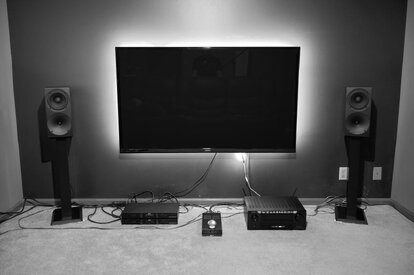
Now, we start measuring and adding the GIK Tri-Traps.
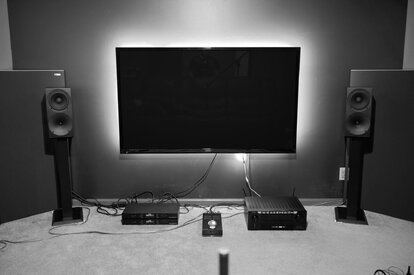
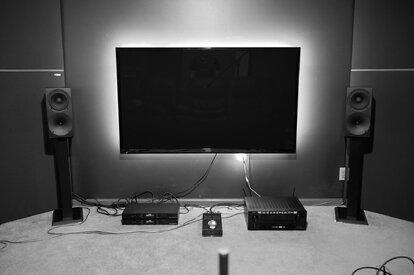
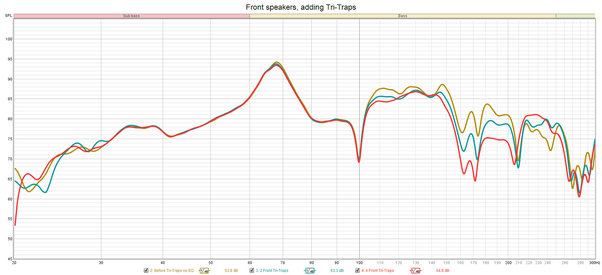
Wait, what is going on here? I thought I was going to improve in that area, not make it worse. Let's zoom in on the 100-350 Hz region:
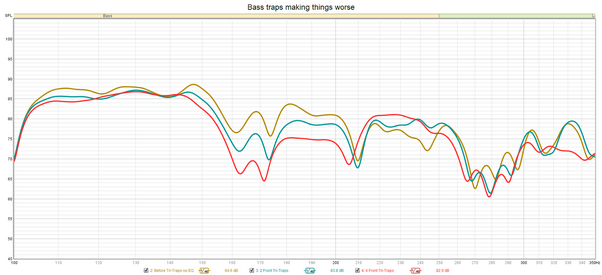
Clearly I am losing output in the very area I'm trying to fix. Maybe the absorption is changing where I need to place my speakers.
(3 hours and countless speaker and chair movements later)
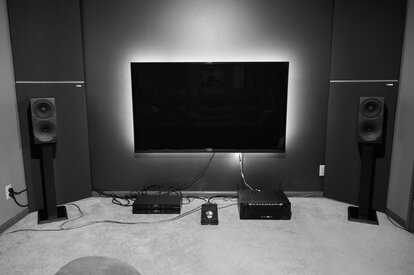
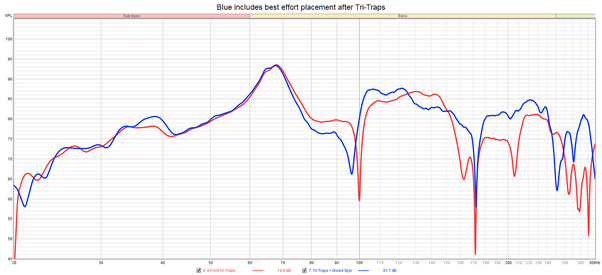
This seems like the best I can do. Let's run Audyssey up to 400 Hz:
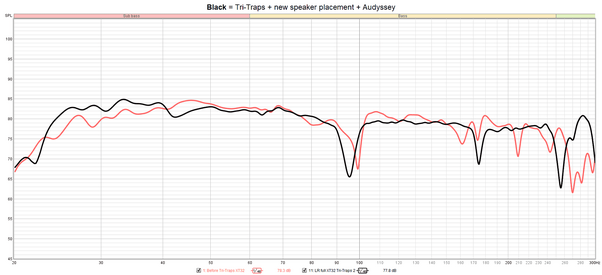
An improvement over the previous effort.
In the end, it is hard to determine just how much the corner traps did for this final measurement as they required me to move my speakers. All of the changes you see below 100 Hz are from moving the speakers, and a good portion of the changes above 100 Hz are, too. I think there is a synergistic effect though, as where the speakers ended up was not previously the best place for them. I would post waterfalls however they were corrupted by the noise from a wicked thunder storm as I was finishing up last night. Some other time.
I have not tried putting the Tri-Traps in the back of the room because there is no space. I thought it made the most sense to start at the front, but it's possible there is a greater benefit there.
Other notes: I am still getting used to the wide placement. I typically have them splashing the walls a bit so I get a big soundstage, as these were designed with their waveguide with great off-axis sound for small rooms (measurements here). With the wide placement, the toe-in is naturally greater and that has created some crazy center imaging. Vocalists may as well be standing in front of my TV they are so present. I am also getting less reflected and more direct sound, which is a bit brighter. I am used to these speakers being a little more laid back as most reviewers describe them. It goes to show how much placement can change what you hear. If you check the company's measurements against mine, you'll see how toe-in would lead to more treble energy, while more wall reflections (old placement) will lead to a greater contribution of off-axis sound which is down in level a bit, which leads to a more rolled-off in-room response.
However when discrete sounds hit the left or right speaker, they don't quite disappear as well in this configuration. I will probably play with this more at a later time. Full-range measurement:
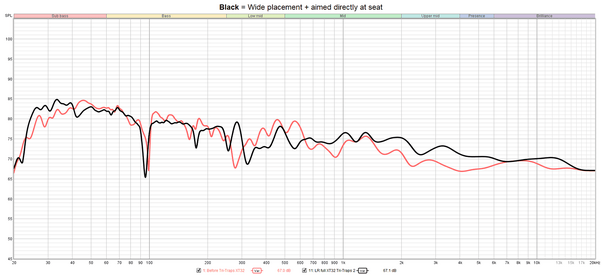
If I can figure out my remaining modes I think I would be looking at a pretty great response for speakers-only. My nemesis right now is the big one at 90-100 Hz that I believe is a width mode down the center of the room. I think I could kill it once I get subs back in here (picture one under the TV), but that requires a higher crossover than I was planning on using. Any ideas?
P.S. – I'm also looking for ideas on stands/racks. Thanks!
Last edited:









